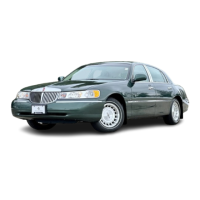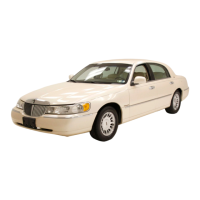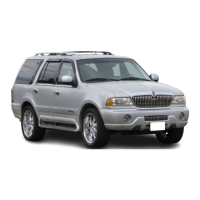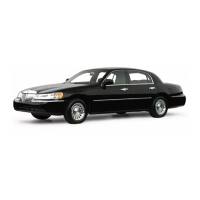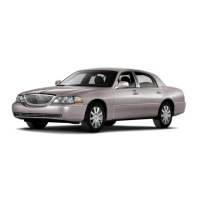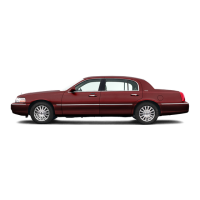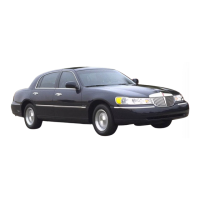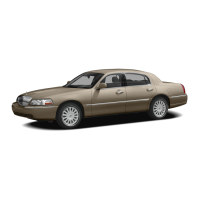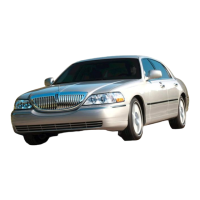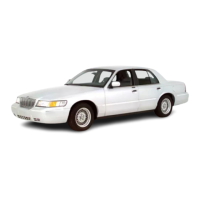Do you have a question about the Lincoln 1997 Town Car and is the answer not in the manual?
Explains Ford's commitment to excellence and achieving the best possible results through dedication.
Lists Ford's core principles including quality, continuous improvement, employee involvement, and partnerships.
Explains the purpose of NOTES for additional information and WARNINGS for caution.
Guides users on how to find specific information using the Quick Index or the Index.
Details the benefits of purchasing the Ford Extended Service Plan (ESP) for extended vehicle protection.
Advises on how to break in new brake linings by avoiding sudden stops and applying brakes gradually.
Explains how the electronic cluster works, including its self-test feature and its role in displaying vehicle conditions.
Provides instructions on what to do if the engine coolant temperature gauge indicates overheating.
Alerts the driver when the fuel level is low, indicated by a flashing fuel pump symbol.
Lists factors that can affect compass readings, such as nearby buildings and metallic objects.
Explains how to reset selected functions in the message center to zero.
Describes the 'Select' function for navigating through message center options.
Explains the 'Distance to Empty' (DTE) function, which estimates remaining driving range based on fuel.
Describes how to display average fuel economy and how to reset the function.
Explains how to calculate instantaneous fuel economy, which reflects current driving conditions.
Provides instructions on operating the new luxury audio system and its various controls.
Explains how to turn the radio on and off using the VOL/PUSH ON knob.
Guides users on how to adjust the radio volume using the knob or steering wheel controls.
Details how to select between AM and FM frequency bands using the dedicated buttons.
Explains how to manually tune radio stations by adjusting frequency increments.
Describes how to use the SEEK function to automatically find the next listenable station.
Details how to use the SCAN function to scan through receivable stations.
Guides on adjusting bass and treble frequencies using the BASS/TREB knob.
Explains how to adjust speaker balance and fader using the BAL/FADE knob.
Explains the procedure for inserting a cassette tape into the player.
Lists various methods to quickly locate a desired track on a cassette tape.
Explains how to fast forward the tape using the player's controls.
Introduces the 10-CD changer unit and its remote operation through the audio system.
Provides step-by-step instructions for loading discs into the CD changer unit.
Details how to start CD playback from the changer, including display indicators.
Explains how to change the current disc being played using the TUNE DISCS button.
Guides on how to change tracks on the current CD using the SEEK button.
States the warranty period for the sound system and advises consulting the vehicle warranty booklet.
Recommends returning the audio system to a dealer for service and mentions the nationwide repair network.
Introduces the EATC module, its location, and its operation when the ignition is on.
Advises taking the EATC to a dealer for service if it is not operating correctly, mentioning built-in diagnostics.
Explains the DRL system for Canadian vehicles, designed to turn on headlamps with reduced output.
Provides instructions for using the autolamp system to control headlamps.
Explains how to set the digital clock by adjusting the hour and minute.
Provides instructions for setting the digital clock.
Explains the different positions of the ignition key and their functions.
Explains the variable interval wiper feature and how to set the interval.
Explains how to check washer fluid levels and the function of the low fluid warning light.
Guides on how to increase the set speed for the speed control system.
Lists features controllable via remote radio controls, such as station selection and volume adjustment.
Lists features controllable via remote climate controls.
Explains how to turn on courtesy and reading lamps, including their location and activation methods.
Illustrates the switch used to operate the moon roof.
Describes the electronic day/night mirror that automatically adjusts to reduce glare.
Provides instructions on how to adjust and use the vehicle's sun visors.
Provides instructions for programming the HomeLink Universal Transmitter.
Offers specific programming advice for Canadian residents.
Guides on training the HomeLink transmitter for garage door openers with rolling codes.
Explains how to set and release the childproof locks on the rear doors.
Describes the power door lock system and its controls on the front door trim panel.
Refers to the illuminated entry system and theater settings.
Explains how to use the master window controls on the driver's door.
Details how to lock out all window switches except the master controls.
Instructions for adjusting seats and mirrors to the desired position.
Explains how to press the SET button to initiate saving a seat/mirror position.
Provides steps for adjusting the vehicle's electric side mirrors.
Details the steps for positioning and installing the floor mat to ensure proper pedal operation.
Provides instructions for manually opening and closing the trunk from the outside using the key.
Lists the locations where the keyless entry code can be found.
Explains how to deactivate the Autolock feature.
Explains how to reactivate the Autolock feature.
Guides on how to program personal entry codes for the keyless entry system.
Explains how to deactivate the Horn Chirp feature.
Explains how to reactivate the Horn Chirp feature.
Explains how the remote entry key fob unlocks doors and recalls memory settings.
Describes how keyless entry codes can be programmed to recall memory seat and mirror settings.
Explains how memory switches on the driver's door recall seat and mirror settings.
Explains how to purchase and program replacement or additional transmitters.
Explains what happens when an unauthorized entry occurs, including system triggers.
Differentiates between a PANIC alarm and a triggered anti-theft alarm.
Provides a sequence of steps to arm the anti-theft system.
Discusses the importance of proper seating and safety restraints.
Explains the importance of head restraints for protecting the head and neck in a collision.
Describes the adjustability of four-way head restraints in different directions.
Guides on how to recline the front manual seats using the recliner handle.
Explains how to operate the heated seat system and its controls.
Explains how to adjust the shoulder belt height for proper positioning and safety.
Explains the two modes of operation for dual locking retractors.
Provides crucial safety precautions regarding the air bag system and its proper use.
Explains the operational mechanism of the air bag system during a collision.
Advises on selecting and installing child safety seats based on child's size and manufacturer instructions.
Instructions for positioning the child seat in the passenger seating position.
Instructions for pulling down the shoulder belt and grasping it with the lap belt.
Explains using seat belts with cinch tongues for installing child seats in rear positions.
Provides key advice for starting fuel-injected engines, emphasizing not pressing the accelerator.
Outlines essential steps to take before starting the vehicle.
Outlines essential steps to take before starting the vehicle.
Offers specific starting procedures for cold engines at different temperature ranges.
Lists steps to take if the engine fails to start after two attempts.
Explains how the anti-lock disc brakes function and how to apply them.
Explains how the anti-lock disc brakes function and how to apply them.
Explains the proper use and setting of the parking brake.
Guides on how to select gears for the automatic transmission.
Describes the gearshift location and the Transmission Control Switch (TCS).
Discusses vehicle weight limits, including GVWR and GAWR, and their importance.
Explains how to calculate vehicle load and stay within weight limits.
Addresses engine starting issues, particularly after a collision or jolt.
Explains the function of the fuel pump shut-off switch and how to reset it.
Provides steps to take if the engine fails to start after two attempts.
Explains that charts identify fuses/breakers protecting electrical parts and their function.
Provides step-by-step instructions for checking and replacing fuses.
Describes the temporary spare tire, its limitations, and identification.
Details preparatory steps before changing a tire, including vehicle securing.
Guides on removing and replacing a tire, including loosening lug nuts.
Illustrates the anti-theft lug nut and the special key required for removal.
Guides on how to remove the anti-theft lug nut using the special key.
Provides instructions for jump-starting a vehicle with a dead battery.
Explains the correct procedure for removing jumper cables after jump-starting.
Advises on contacting towing services and describes typical towing options.
Explains rear towing methods and what information to provide to the tow truck operator.
Outlines Ford's goals for vehicle servicing: designing low-maintenance parts and making servicing easy.
Advises on protecting oneself during vehicle repairs, emphasizing the use of genuine Ford parts.
Lists safety precautions and steps to take when working on the vehicle with the engine off.
Provides step-by-step instructions for opening the vehicle's hood.
Instructs on releasing the auxiliary latch located under the hood.
Explains how to lift and hold the hood open using lift cylinders.
Lists oils and additives that should not be used in the engine.
Details the steps for checking the engine oil level using the dipstick.
Provides first aid instructions for brake fluid contact with eyes or skin.
Explains how to check washer fluid levels and the function of the low fluid warning light.
Provides instructions for checking engine coolant levels and safety precautions.
Warns that engine coolant sprayed on the windshield can impair visibility.
Advises on coolant mixture for severe winter climates.
Provides steps for checking and adding power steering fluid.
Guides on checking automatic transmission fluid levels under specific operating conditions.
Discusses battery maintenance, including checking electrolyte levels.
Explains when and how to replace wiper blade assemblies or elements.
Explains the importance of tire rotation for even wear and longevity.
Advises on replacing tires that show wear bands.
Provides the official U.S. DOT information on tire quality grades.
Advises on using snow tires and chains in winter conditions and proper installation.
Illustrates the button used to open the fuel door.
Details the procedure for removing the fuel cap and checking for pressure.
Specifies the recommended octane rating for the vehicle's gasoline.
Mentions Ford's approval of reformulated gasolines for cleaner air.
Provides crucial safety information regarding the handling and use of automotive fuels.
Explains how fuel economy is estimated and calculated in MPG or L/100K.
Provides a step-by-step guide for calculating fuel economy.
Lists factors that can decrease a vehicle's fuel economy.
Explains how to maintain the emission control system for proper function.
Guides on preparing the vehicle for Inspection/Maintenance (I/M) testing, especially after service.
Advises checking various vehicle lights and provides information on bulb replacement.
Provides safety warnings for handling halogen headlamp bulbs.
Ensures the headlamp switch is off before starting bulb removal.
Guides on installing a new headlamp bulb, including alignment checks.
Provides instructions for washing and polishing the vehicle's exterior, including what to avoid.
Lists specific actions to avoid when washing the vehicle.
Provides cleaning instructions for leather seat surfaces.
Guides on cleaning fabric upholstery, including spot removal.
Lists refill capacities, Motorcraft parts, and lubricant specifications for the vehicle.
Provides a table of Motorcraft parts with their corresponding part numbers.
Offers maintenance tips to ensure the vehicle stays in good operating condition during storage.
Provides general recommendations for vehicle storage.
Provides guidance on washing, polishing, and lubricating vehicle body components.
Outlines fuel system maintenance, including filling the tank and using quality fuel.
Advises on protecting the cooling system against freezing temperatures.
Guides on checking and recharging the vehicle battery.
Provides contact information for reporting vehicle safety defects to NHTSA.
Guides on obtaining service or maintenance for the vehicle from authorized Ford/Lincoln-Mercury dealerships.
Outlines Ford's recommendations for vehicle service and maintenance concerns in the US and Canada.
Describes the Dispute Settlement Board as an independent arbitration program for warranty disputes.
Lists the information required for the Board to review a case.
Explains how Board members review information and make decisions on warranty complaints.
Provides contact information for Ford of Canada Customer Assistance.
Describes the CAMVAP program in Canada for resolving vehicle service concerns.
Lists available Ford accessories and their warranty information.
Lists engine type, fuel requirements, and capacities.
Specifies fuel type and tank capacity.
States the vehicle's fuel tank capacity in gallons and liters.
Refers to the Tire Pressure Decal for tire size information.
Indicates where to find tire pressure specifications.
Describes the location of the hood release handle.
Recommends engine oil type and specifications.
States the engine oil capacity.
Specifies the type of automatic transmission fluid recommended.
| Brand | Lincoln |
|---|---|
| Model | 1997 Town Car |
| Category | Automobile |
| Language | English |
